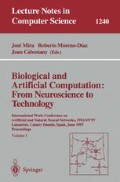Abstract
Industrial and municipal wastewaters constitute major sources of contamination of the aquatic compartment and represent a threat to the aquatic life. Artificial neural networks, based on three different learning paradigms, were studied to predict the acute toxicity of trouts (5 days exposure to wastewaters) with the inputs of two simple microbiotests which requires only 5 and 15 min incubation time. These microbiotests were 1) the chemoluminescent peroxidase (CI-Per) assay which can detect radical scavengers and enzyme-inhibiting substances, and 2) the bacterial luminescent toxicity test (MicrotoxTM) which is responsive to toxic substances affecting the vital function of bacteria. The responses obtained with the the trout bioassay, the C1-Per and the MicrotoxTM microbiotests were analyzed for statistical correlations (Pearson-moment correlation), unsupervised learning by self-organizing network, and assisted learning by the backpropagation and the Hopfield (probabilistic) paradigms. The results showed that no significant correlation (p<0.05) was obtained between either the responses obtained with Cl-Per (p = 0.121) or the MicrotoxTM (p = 0.061) microbiotests with the ones obtained with the trout bioassay. The self-organizing network was able to identify by itself a maximum number of 5 classes that were more or less related to fish toxicity: class 1 contained 2 samples that were toxic to fish, class 2 contained 2/3 samples that were toxic to fish, class 3 showed 6/8 samples that were not toxic, class 4 contained 5/6 samples that were non-toxic and class 5 identified one sample that was toxic. Supervised learning with backpropagation analysis yielded 2 kinds of networks that proved promising. The first one, was able to predict the actual toxic wastewater concentration with an overall performance of 65 % with unseen data while the second one, which was designed to identify toxic effluents from those that were not, had a much better performance (90 %). However, the probabilistic network proved also a very good prediction model to predict toxicity to fish with an overall performance of 90 %. Although more data is needed, the network based on the backpropagation paradigm seems a better predictor or classifier of trout toxicity with the Cl-Per and the MicrotoxTM microbiotests.
Preview
Unable to display preview. Download preview PDF.
References
Awong, J. G. Bitton, B. Koopman and J.L. Morel. 1989 Evaluation of ATP photometer for toxicity testing using MicrotoxTM luminescent bacterial reagent. Bull. Environ. Contam. Toxicol. 43, 118–122.
Babich, H., and E. Borenfreund. 1991. Cytotoxicity/genotoxicity assays with cultured fish cells: a review. Toxicol. In vitro 5, 91–100.
Bergman, H.L., R.A. Kimerle, and A.W. Maki. 1986. Environmental hazard assessment of effluents. Pergamon Press, New York, USA.
Blaise, C., Van Coillie, R., Bermingham, N., Coulombe, G. 1987. Comparaison des réponses toxiques de trois indicateurs biologiques (nactéries, algues, poissons) exposés à des effluents de fabriques de pâtes et papiers. Revue Int. Sci. Eaux 3, 9–17.
Bhagat, P. 1990 An introduction to neural nets. Chem.Eng.Prog. August, 55–60
Clark, J.W. 1991 Neural network modelling. Phys.Med.Biol. 36, 1259–1317.
Calleja, M.C., Geladi, P. and Persoone, G. 1994 Modelling of human acute toxicity from physicochemical properties and non-verterbrate acute toxicity of the 38 organic chemicals of the MEIC priority list by PLS regression and neural network. Food Chemistry and toxicity 32, 923–941.
Collins, M. 1993 Empiricism strikes back: neural networks in biotechnology. Biotechnology 11, 163–166.
Environment Canada. 1990. Biological test method, acute lethality test method using rainbow trout. Conservation and Protection, Environment Canada, Ottawa. Report No. EPS I/RM/9.
Environment Canada. 1992 Biological test method: Toxicity test using luminescent bacteria (Photobacterium phosphoreum). Report EPS 1/RM/24, Environmental protection Series. Ottawa, Canada.
Feuston-MH; Feuston-BP; Hamilton-CE; Mackerer-CR 1994 An improved neural net model for predicting developmental toxicity of refinery streams. Teratology 49, 416.
Gagné, F. and Blaise, C. 1997. Evaluation of industrial wastewater quality with a chemiluminescent peroxidase activity assay. Environ. Toxic. Wat. Qual. In press.
Gagné, F. and Blaise, C. 1997 Validation of rainbow trout hepatocyte model for ecotoxicity testing of industrial wastewaters. Environ, Toxic. Wat. Qual. In press.
Ribo, J.M., and Kaiser, K.L.E. 1987 Photobacterium phosphoreum Toxicity bioassay. 1 Test procedures and applications. Toxic. Assessm. 2, 305–323.
Whitehead, T.P., Thorpe, G., Lane, M., Watson, A., and Billings, C. 1993. A rapid and simple chemiluminescent assay for water quality monitoring. Biology Perspect., 377–381.
Author information
Authors and Affiliations
Editor information
Rights and permissions
Copyright information
© 1997 Springer-Verlag Berlin Heidelberg
About this paper
Cite this paper
Gagné, F., Blaise, C. (1997). Predicting toxicity of complex mixtures by artificial neural networks. In: Mira, J., Moreno-Díaz, R., Cabestany, J. (eds) Biological and Artificial Computation: From Neuroscience to Technology. IWANN 1997. Lecture Notes in Computer Science, vol 1240. Springer, Berlin, Heidelberg. https://doi.org/10.1007/BFb0032517
Download citation
DOI: https://doi.org/10.1007/BFb0032517
Published:
Publisher Name: Springer, Berlin, Heidelberg
Print ISBN: 978-3-540-63047-0
Online ISBN: 978-3-540-69074-0
eBook Packages: Springer Book Archive

